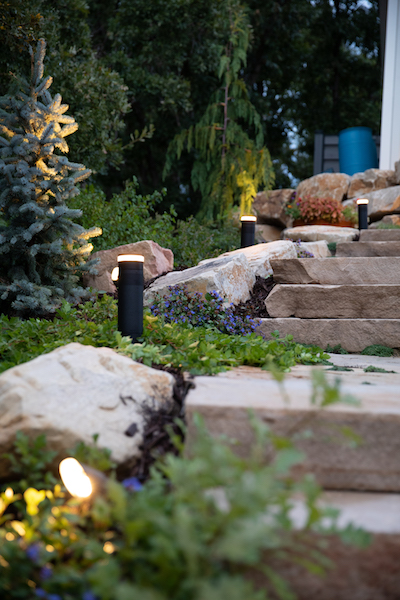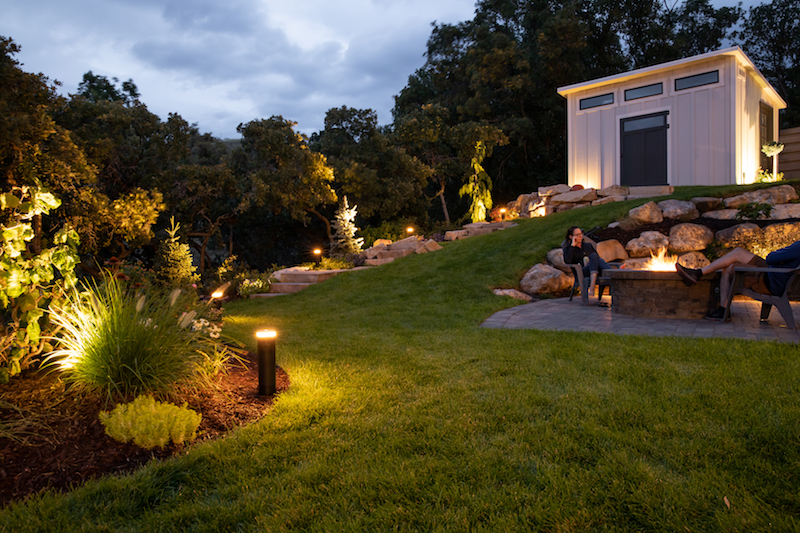Summer is here, which means homeowners are upgrading their outdoor entertainment spaces. It’s no secret that lighting is one of the most sought-after tech upgrades, which makes it an easier sell for the integration community. But despite this, it’s difficult to communicate how lighting can turn a dull area into a beautiful recreational space without actually experiencing it.
This presents an opportunity; when lighting is methodically designed and installed outdoors, with the right fixtures positioned and automation functionality, it can create magic.
Plus, the industry is always changing. Homeowners may think they know the extent of what outdoor lighting can do, but creative applications, smarter technology and new design schemes are propelling the industry forward. Knowing these new trends will help keep business booming and continue to thrill customers with stunning outdoor recreational spaces.
The Future is Up
We typically illuminate outdoor spaces at ground level. It’s certainly a good plan to accentuate paths and planting, but don’t forget about the areas above eye level. Lighting designers and landscapers often choose to get creative by placing light high up in certain trees and angling the fixtures downward to create an effect similar to moonlight.

Sometimes, they may choose to place a few lights at the base of a tree shining upward to accentuate the textures, the bark of trees, and a canopy of leaves. When doing so, however, lighting designers should be mindful of light pollution and make sure that the lighting is focused and hits directly on the trees and surrounding foliage as much as possible to avoid lighting that shoots directly into the sky.
Let Nature Take Center Stage
Understated fixtures that blend in — or even seem to disappear — are becoming the go-to approach for outdoor lighting, as are fixtures utilizing LED technology for greater efficiency and longer lifespan. Leveraging the timeless, sophisticated aesthetic of a simple, minimalistic form factor are fixtures designed to withstand inclement weather conditions. Durable and rugged, yet elegant and eye-catching, today’s trending fixtures combine style with substance.
Take Root in New Places
Pathway lighting, while necessary, is usually not the most creative or expressive application of outdoor lighting. Let’s think beyond the basics and extend our systems to other lesser-known spots in the yard to lend greater visual interest to the property. Outdoor fixtures come in all shapes and sizes, like linear tape lighting, so they can be discreetly applied to the underside of steps, tucked within the capstone of a handrail and recessed into the eaves, for example. Lights resembling tiles can be laid within a driveway or recessed around a swimming pool.
Warm it Up
Like in fashion, certain trends can veer into tacky territory and are best avoided. Keeping the color temperature of outdoor fixtures at a cool, “moonlight” setting seems to be the go-to approach. On the surface it makes sense: Moonlight is beautiful, and it occurs naturally at night, so why not emulate the effect with outdoor lighting? Unfortunately, the comparison doesn’t translate. Artificial “moonlight” puts off a cold, harsh, bluish hue — good for security purposes but certainly not design-friendly. To evoke a warmer, subtle glow that’s way more pleasing to the eye, the color temperature of outdoor fixtures should be set at 2200-2700 Kelvin.
Automate the Experience
Consumers want lighting that looks and feels luxurious, not obnoxious, fueling a desire for greater control of the illumination. A simple on/off switch no longer does lighting justice. Dividing the layout into zones, creating custom lighting scenes, and automating the fixtures to dim and brighten under certain prescribed conditions elevates the whole experience. As outdoor light fixtures continue to evolve, so must the mode of operation.
It’s time to take outdoor lighting up a notch. Your clients are ready for it and manufacturers offer a plethora of designs and technologies to support more beautiful, functional, and customizable outdoor illumination. Know the trends before you dig into the landscape to ensure a stylish, sustainable, smart system that adds real value to a home and its occupants.
Future-Proof Systems for Change
The landscape and topology you’re dealing with today will likely be much different a few years down the road. Trees and plantings grow, decks are added and expanded, areas are cleared and resurfaced for new gardens — the outdoors is a living, breathing entity that morphs and evolves continuously. Therefore, outdoor lighting will need to adjust accordingly. This has inspired manufacturers to design fixtures with interchangeable parts — instead of removing an old fixture and replacing it with a new one, today’s trending fixtures can shift location easily and lenses can be swapped to create the now-desired effect.









